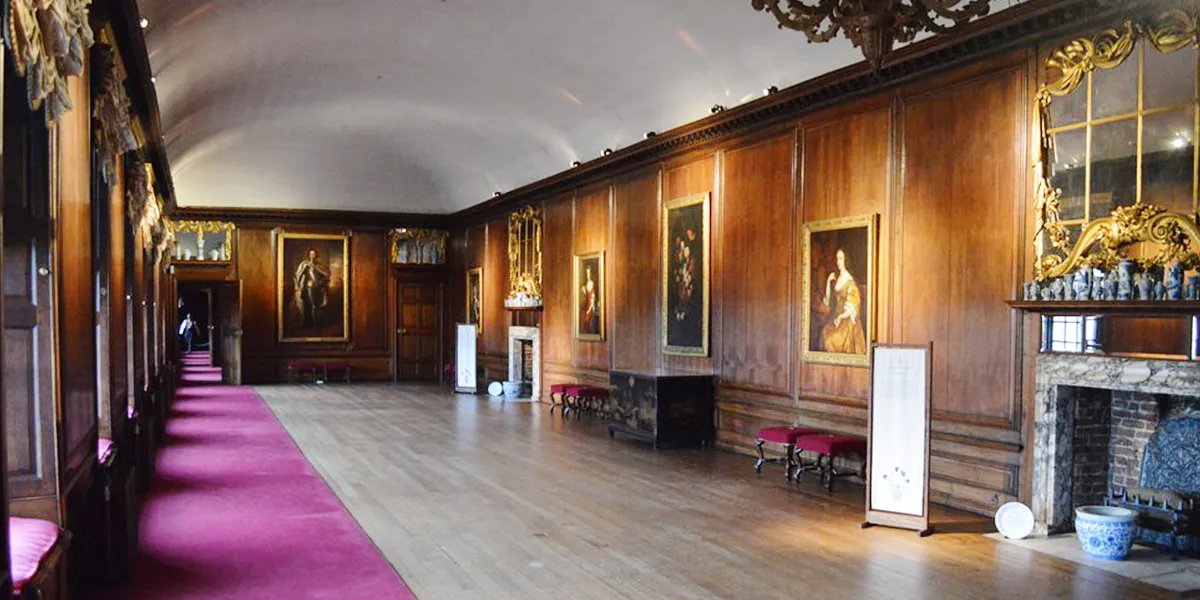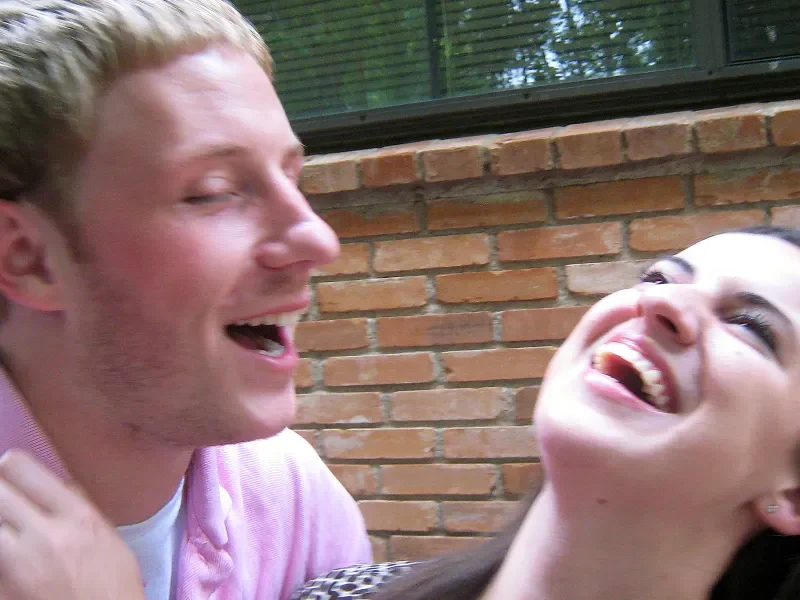She walked in, soaked, ignored, and judged, then pointed to a painting and said, “That’s mine.” I didn’t know it at the time, but uncovering the truth behind her words would turn my entire gallery upside down and bring someone unexpected to my doorstep.
My name’s Tyler. I’m 36, and I run a modest art gallery in downtown Seattle. It’s not one of those flashy places filled with critics and wine-soaked chatter on opening nights. It’s quieter, more personal, and in many ways, it feels like an extension of who I am.
I inherited a love for art from my mom. She was a ceramicist who never sold a single piece but filled our tiny apartment with color. After losing her during my final year at art school, I dropped the brushes and picked up the business side instead.
Owning a gallery became my way of staying close to her without losing myself in grief. Most days, I’m here alone, curating local work, making conversation with regulars, and keeping things steady.
The space itself feels warm. Soft jazz drifts from speakers tucked into the ceiling corners. The polished oak floors creak just enough to ground the quiet of the gallery. Gold-framed pieces line the walls, catching the golden light at just the right angles.
It’s the kind of place where people speak in low voices and pretend they understand every brushstroke, which, honestly, I don’t mind. That calm, composed air keeps the chaos of the outside world at bay.
But then came her.
It was a Thursday afternoon, wet and overcast like most days here. I was adjusting a tilted print by the entrance when I noticed someone standing outside.
She was an older woman, probably in her late 60s, with the look of someone who had been forgotten by the world. She stood beneath the awning, trying not to shiver.
Her coat looked like it belonged to another decade, thin and clinging to her like it had long since stopped knowing how to keep anyone warm. Her gray hair was tangled and flattened by the rain. She stood as if she were trying to disappear into the bricks behind her.
I paused, unsure of what to do.
Then the regulars arrived. Right on cue, three of them swept in with the smell of expensive perfume and opinions. Older women, decked out in tailored coats and silk scarves, their heels clicking like punctuation marks.
The moment they saw her, the temperature in the room dropped.
“Oh my God, the smell,” one of them muttered, leaning toward her friend as if to shield herself.
“She’s dripping water all over my shoes,” another one snapped.
“Sir, can you believe this? Get her out!” the third said loudly, looking straight at me with sharp, expectant eyes.
I looked at the woman again. She was still outside, trying to decide if it was safer to stay or run.
“She’s… wearing that coat again?” someone added behind me. “It looks like it hasn’t been washed since the Reagan administration.”
“She can’t even afford decent shoes,” the first woman said with a scoff.
“Why would anyone let her in?” came the final judgment, exasperated and loud.
Through the glass, I saw the way her shoulders folded in. Not like she was ashamed, but like she’d heard all of it before. Like it was background noise by now, but still enough to sting.
My assistant, Kelly, a 20-something art history grad, glanced at me nervously. She had kind eyes and a voice so soft it often got lost in the hum of the gallery.
“Do you want me to —” she started, but I cut her off.
“No,” I said. “Let her stay.”
Kelly hesitated, then gave a small nod and stepped aside.
The woman walked in, slow and cautious. The bell above the door chimed like it didn’t quite know how to announce her. Water dripped from her boots and made dark blotches on the wood. Her coat hung open, threadbare and soaked, revealing a faded sweatshirt underneath.
I could hear the whispers around me sharpen.
“She doesn’t belong here.”
“She probably can’t even spell ‘gallery.'”
“She’s ruining the vibe.”
I didn’t say anything. My fists were clenched at my sides, but I kept my voice even, my expression calm. I watched her walk through the space like every painting held a piece of her story. Not with confusion or hesitation, but with focus. Like she saw something most of us didn’t.
I stepped closer and studied her more carefully. Her eyes weren’t dull like the others assumed. They were sharp, even behind the wrinkles and weariness. She paused in front of a small impressionist piece, a woman sitting under a cherry blossom tree, and tilted her head slightly, as if trying to remember something.
Then she moved on, past the abstracts and portraits, until she reached the far wall.
That’s when she stopped.
It was one of the larger pieces in the gallery, a city skyline at sunrise. Vivid oranges spilled into deep purples, the sky bleeding into the silhouette of buildings. I’d always loved that piece. It carried a quiet sense of grief, like something was ending even as it began.
She stared at it, frozen.
“That’s… mine. I painted it,” she whispered.
I turned to her. At first, I thought I’d misheard.
The room went silent. It wasn’t the respectful kind of silence, but the kind that comes just before a storm. Then came the laugh, loud and sharp, bouncing off the walls like it was meant to cut.
“Sure, honey,” one of the women said. “That’s yours? Maybe you painted the Mona Lisa, too.”
Another one chuckled and leaned in toward her friend. “Can you imagine? She probably hasn’t even taken a shower this week. Look at that coat.”
“She’s delusional,” someone said behind me. “Honestly, this is getting sad.”
But the woman didn’t flinch. Her face didn’t change, except for a tiny lift in her chin. She raised a trembling hand and pointed to the bottom right corner of the painting.
There it was. Barely visible, hidden beneath the glaze and texture, tucked beside the shadow of a building: M. L.
I felt something shift inside me.
I had purchased the painting at a local estate sale almost two years ago. The previous owner mentioned it came from a storage unit they had cleaned out. They had thrown in the piece with a few others, no history, no paperwork. I liked it.
It spoke to me. But I had never been able to trace the artist. Just those faded initials.
Now she stood in front of it, not demanding, not dramatic, just still.
“That’s my sunrise,” she said softly. “I remember every brushstroke.”
The room stayed quiet, the kind of quiet that grows teeth. I looked around at the patrons, their smugness beginning to waver. No one knew what to say.
I stepped forward.
“What’s your name?” I asked gently.
She turned to me. “Marla,” she said. “Lavigne.”
And something in me, something deep and unsettled, told me this story wasn’t over yet.
“Marla?” I said quietly, stepping closer to her. “Sit down for a moment. Let’s talk.”
She looked around the room like she didn’t quite believe I meant it. Her eyes, still locked on the painting, flicked toward the sneering faces nearby, then back to me. After a long pause, she gave a tiny nod.
Kelly, ever the quiet hero, appeared with a chair before I even asked. Marla sat down slowly and carefully, as if she might break something just by being there, or maybe as if she were afraid someone would ask her to leave at any moment.
Around us, the atmosphere buzzed with discomfort. The same women who had scowled at her now stood with their backs turned, pretending to admire nearby pieces while still whispering, their words soaked in judgment.
I crouched beside Marla so we were eye to eye. Her voice was barely above a whisper when she said, “My name is Marla.”
“I’m Tyler,” I said gently.
She nodded once. “I… I painted this. Years ago. Before… everything.”
I leaned in slightly. “Before what?”
Her lips pressed together for a moment. Then her voice cracked.
“There was a fire,” she said. “Our apartment. My studio. My husband didn’t make it out. I lost everything in one night. My home, my work, my name… everything. And later, when I tried to rebuild, I found out that someone had taken my work. Sold it. Used my name like it was some faded label. I didn’t know how to fight it. I became… invisible.”
She stopped talking, staring down at her hands. Her fingers were worn, lined with paint stains even now. The gallery was still filled with murmurs, but I barely heard them anymore. My focus was on her. The woman behind the initials.
“You’re not invisible,” I said. “Not anymore.”
Her eyes welled with tears, but she didn’t let them fall. She just looked up at the painting again, like seeing a piece of her soul that had been torn away and returned.
That night, I couldn’t sleep.
I sat at my dining table with a pile of old records, paper receipts, auction catalogs, and handwritten notes. My coffee had gone cold hours ago, and my neck ached from bending over my laptop. Still, I kept going.
The painting had come from a private estate sale. That much I knew. But everything before that was murky. Over the next few days, I called collectors, searched through gallery archives, and even dug through old newspaper listings.
Kelly helped whenever she could; her research skills put mine to shame. Finally, after hours of searching, I found it: a faded photograph tucked into the back pages of an archived gallery brochure from 1990.
The photo stopped me cold.
There she was. Marla looked to be in her 30s in the picture, standing proudly in front of the piece, her eyes bright and her smile wide. She wore a simple, sea-green dress. It was unmistakably the same painting — same initials, same composition. The plaque beneath it clearly read: “Dawn Over Ashes, by Ms. Lavigne.”
I printed the photo and brought it to her the next day. She was sitting quietly in the gallery, sipping tea Kelly had made her, her body still hunched from years of carrying invisible weight.
“Do you recognize this?” I asked, holding it out.
She took it slowly, then gasped. Her fingers trembled as she brought it closer to her face.
“I thought it was all gone,” she whispered, voice raw.
“It’s not. And we’re going to fix this,” I told her. “You’re getting your name back.”
From that day, things moved quickly. I pulled every piece in the gallery that had her faded initials, M. L., in the corner and took them off display. We began relabeling them with her full name and started building provenance around each one.
I contacted auction houses and requested corrections to sales records. Kelly even tracked down old press mentions and signed gallery agreements that confirmed Marla’s authorship.
There was one name that kept coming up: Charles. Last name Ryland. He was a gallery owner turned agent who had supposedly “discovered” Marla’s paintings back in the ’90s.
For years, he had been selling them under a fabricated story. According to the records, he claimed ownership through a so-called lost partnership. No signatures. No contracts. Just his words and a whole lot of greed.
Marla didn’t want to see him. She said it wasn’t revenge she wanted, just the truth.
Still, I knew he’d come eventually.
And when he did, it was loud.
He stormed into the gallery one Tuesday morning, red-faced and puffing like a man used to getting his way.
“Where is she?” he demanded. “What is this nonsense you’re spreading?”
Marla was in the back studio. I stood between him and the doorway.
“This isn’t nonsense, Charles. We’ve got documents, photos, and press mentions. It’s over.”
He laughed, but it was brittle. “You think this’ll hold up? I legally own those pieces. I bought them. The law’s on my side.”
“No, you forged authorship,” I said calmly. “You erased her name from history, and now you’re going to answer for it.”
He turned to leave, muttering about lawyers and lawsuits, but he never got the chance. Two weeks later, after we submitted our file to the district attorney and a local investigative reporter got involved, he was arrested on charges of fraud and forgery.
Marla didn’t gloat. She didn’t even smile. She just stood at the edge of the gallery with her arms crossed and her eyes closed, like she was trying to remember what breathing without fear felt like.
“I don’t want him ruined,” she told me one evening. “I just want to exist again. I want my name back.”
And she got it.
Over the next few months, the same people who had once sneered at her became quiet admirers. A few even apologized in hushed tones. One woman in a burgundy trench coat brought her daughter and stood in front of Dawn Over Ashes, whispering, “I misjudged her. I’m sorry.”
Marla began painting again, properly this time. I offered her the back room of the gallery as a studio, and she accepted. It had tall windows that caught the morning sun and carried in the scent of coffee from the café next door. Every morning, she arrived early, her hair tied up, a brush in one hand and hope in the other.
She started offering small afternoon classes for kids from the neighborhood. She told them that art wasn’t just about color, but about feeling. It was about turning pain into something that made people stop and look.
One morning, I found her helping a shy little boy with charcoal sketches. He had trouble speaking, but his eyes lit up every time Marla encouraged him.
“Art is therapy,” she said to me later that day. “That boy sees the world in his own way. Just like I used to. Just like I still do.”
Then came the exhibit.
We called it Dawn Over Ashes, at her suggestion. It featured all her pieces — the old ones, freshly cleaned and reframed, and the new ones, full of light and confidence. Word spread fast. By opening night, the gallery was packed.
People came in quietly at first. Then the room filled with the soft hum of wonder. Paintings that had once been dismissed now pulled in crowds. Her use of light and the way she captured emotion made it feel like people were seeing them for the first time.
Marla stood near the center of the gallery, wearing a deep blue shawl over a simple black dress. She looked proud without being boastful, calm, and at peace. Her cheeks were slightly flushed, and her smile was gentle but steady.
When she stepped up to Dawn Over Ashes, I walked over and stood beside her. She reached out and brushed her fingers lightly across the edge of the frame.
“This was the beginning,” she said quietly.
I nodded. “And this is the next chapter.”
She turned to me, eyes wet with joy.
“You gave me my life back,” she said.
I shook my head, smiling. “No. You painted it back yourself.”
The lights dimmed a little, just enough to soften the room. Applause began to swell, not wild or theatrical, but warm and full of respect. Marla took a small step forward, then looked back at me. Her voice was barely a whisper.
“I think… this time, I’ll sign it in gold.”


